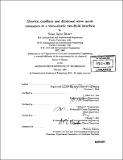| dc.contributor.advisor | Dick Y.P. Yue and Michael S. Triantafyllou. | en_US |
| dc.contributor.author | Brown, Susan Jayne, 1967- | en_US |
| dc.contributor.other | Massachusetts Institute of Technology. Dept. of Civil and Environmental Engineering. | en_US |
| dc.date.accessioned | 2005-09-27T19:07:55Z | |
| dc.date.available | 2005-09-27T19:07:55Z | |
| dc.date.copyright | 2005 | en_US |
| dc.date.issued | 2005 | en_US |
| dc.identifier.uri | http://hdl.handle.net/1721.1/28931 | |
| dc.description | Thesis (Sc. D.)--Massachusetts Institute of Technology, Dept. of Civil and Environmental Engineering, 2005. | en_US |
| dc.description | Includes bibliographical references (p. 222-226). | en_US |
| dc.description.abstract | (cont.) space corresponding to experimental conditions to thereby interpret the experimental results. We tested this method on noisy simulated data sets and then applied it to published experimental data sets. We designed an experimental set-up to measure wave number, spatial damping coefficient, and wave slope data for a 3-10 hertz frequency range of transverse and longitudinal waves in a clean enclosed flume. We used kimball-mounted lasers whose beams passed through optical glass in the tank and lid to capture transverse wave motion. The experimental conditions included waves traveling on fatty acid monolayers on aqueous solutions and also waves traveling on a visco-elastic fluid at a variety of temperatures. In addition to the wave data we obtained, we also measured in-situ surface tension. Analyzing the experimental data, we demonstrated the effects of modulation of one wave mode on another. We obtained the rheological parameters for these experimental systems by the inverse method. We used the inverse method to construct the dispersion relation solution space corresponding to the experimental conditions. We used the diagnostic tools for root classification, spatial stability together with a graphical representation of the dispersion relation solution space to understand the physics underlying our experiments. We demonstrated resonance phenomena experimentally with the wave data from the visco-elastic fluid and confirmed this resonance numerically: gravity-capillary resonance near 4.2 hertz ... | en_US |
| dc.description.abstract | This thesis is a study of first order resonance between gravity, capillary and dilational wave modes. Gravity, capillary and dilational waves, occurring at a visco-elastic interface between two fluids, are different modes described by a single linear dispersion relation. Gravity and capillary modes arise due to the restoring forces of surface tension and gravity and result in oscillatory motions transverse to the surface. The dilational, or Marangoni, modes arise due to the elastic nature of the interface and result in longitudinal motion along the interface. The visco-elasticity of the interface may be due to the interfacial nature of the two fluids or it may be due to the presence of a monolayer of surfactant, such as a film on the ocean surface. This visco-elasticity affects the interfacial stress balance and is accounted for in the dispersion relation via interfacial heological parameters. We described resonance as coalescence of the roots of the dispersion relation in complex frequency and wave number space. We used this description to explain numerical and experimental resonance phenomena noted in previous studies. We classified some of the roots of the dispersion relation as primarily gravity, capillary or dilational modes. We numerically determined the dependence on interfacial rheology of root coalescence (resonance) and the boundaries of spatial stability of the modes. We used these diagnostic tools to characterize the conditions for both gravity-capillary and capillary-dilational modal resonances. We developed an inverse method from which interfacial rheological parameters can be determined from experimental measurements of wave number, frequency and spatial damping coefficient. We used this tool to construct the dispersion relation solution | en_US |
| dc.description.statementofresponsibility | by Susan Jayne Brown. | en_US |
| dc.format.extent | 226 p. | en_US |
| dc.format.extent | 9624206 bytes | |
| dc.format.extent | 9653374 bytes | |
| dc.format.mimetype | application/pdf | |
| dc.format.mimetype | application/pdf | |
| dc.language.iso | en_US | |
| dc.publisher | Massachusetts Institute of Technology | en_US |
| dc.rights | M.I.T. theses are protected by copyright. They may be viewed from this source for any purpose, but reproduction or distribution in any format is prohibited without written permission. See provided URL for inquiries about permission. | en_US |
| dc.rights.uri | http://dspace.mit.edu/handle/1721.1/7582 | |
| dc.subject | Civil and Environmental Engineering. | en_US |
| dc.title | Gravity, capillary and dilational wave mode resonance at a visco-elastic two-fluid interface | en_US |
| dc.type | Thesis | en_US |
| dc.description.degree | Sc.D. | en_US |
| dc.contributor.department | Massachusetts Institute of Technology. Department of Civil and Environmental Engineering | |
| dc.identifier.oclc | 60525439 | en_US |
